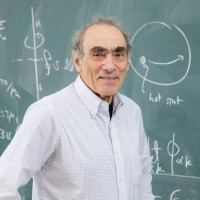The Evolution of Primordial Neutrino Helicities under Gravitational and Magnetic Fields and Implications for their Detection
- 日時
- 2021年2月22日(月)10:00 - 11:30 (JST)
- 講演者
-
- ゴードン・ベイム (理化学研究所 数理創造プログラム (iTHEMS) 客員主管研究員 / Professor Emeritus, University of Illinois, USA)
- 会場
- via Online
- 言語
- 英語
Feb.22 (Mon) 10:00am-11:30am (JST)
Primordial neutrinos decoupled in the early universe in helicity eigenstates. As I will discuss, two effects -- dependent on neutrinos having a non-zero mass -- can modify their helicities as they propagate through the cosmos. First, finite mass neutrinos have a magnetic moment and thus their spins, but not their momenta, precess in cosmic and galactic magnetic fields. The second is the propagation of neutrinos past cosmic matter density fluctuations, which bend their momenta, and bend their spins by a smaller amount. (The latter is a general relativistic effect.) Both effects turn a fraction of left-handed neutrinos into right-handed neutrinos, and right-handed antineutrinos into left-handed. If neutrino magnetic moments approach that suggested by the XENON1T experiment as a possible explanation of their excess of low energy electron events -- a value well beyond the moment predicted by the standard model -- helicities of relic Dirac (but not Majorana) neutrinos could be considerably randomized. I finally will discuss the implications of neutrino helicity rotation, as well as their Dirac vs. Majorana nature, on their detection rates via the Inverse Tritium Beta Decay reaction.
*Detailed information about the seminar refer to the email.


